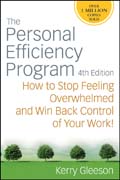
The personal efficiency program: how to stop feeling overwhelmed and win back control of your work
Gleeson, Kerry
INDICE: WORLDWIDE OPPORTUNITIES WITH IBT. PREFACE. ACKNOWLEDGMENTS. INTRODUCTION. Origin of the Personal Efficiency Program. How to Work. CHAPTER 1: Executive Summary. Get Organized. Habits and Routines. Batching Work. Planning. Continuous Improvement of the Process (Kaizen). CHAPTER 2: Do It Now! Why the Personal Efficiency Program Works. Start with Your Desk or Work Space. Overcoming Procrastination. Not Everything Can or Should Be Done Now. Build Decisiveness into Your Work Habits. Establish Do It Now Work Habits. Perfection. Discipline. Follow-Up for Chapter 2. CHAPTER 3: Organize It Now! A Soldiers Story. Cleaning Out the Clutter. Where Does Clutter Come From? Why Clutter Stays There. Out of Sight? Dont Overlook the Obvious. Start with the Basics. Your Office Toolbox. Become Familiar with Tools as They Come on the Market. Organizing FilesBeginning with Paper. Working Files. Tickler System. Setting Up Your Personal Working Files. Your Personal Reference Files: Note Things to Do as You Come across Them. Archive Files. TipsWhat to Keep, Where to Keep It, and What to Throw Away. Tips for Improving Your Paper Filing System. Filing and Labeling. Organizing Electronic Files. Where to BeginThe Computers Operating System. Back UpYour Hard Drive. Naming Electronic Files. Let the Computer Find Your Documents for You. Organizing E-Mail. Steps to Organize E-Mail. Creating and Organizing Your E-Mail Address Book. Organizing BookmarksWeb Pages You May Wish to Access in the Future. Organizing the Computer Desktop to Access Applications and Files Easily. Using Search Functions. Organizing Other Media. Summary. Follow-Up for Chapter 3. CHAPTER 4: Do It Routinely. Keep a Time Log. Electronic Time Log. Overcome Information Overload. Beyond the In Basket. Batch the Routine Work. Schedule and Avoid Having to Decide. Parkinsons Law and the Allocation of Time. Blocks of Time. Batching Telephone Calls. One More Thing! Batching E-Mail. Paper Mail/Memos. Reading. Weekly One-on-One Meetings. Daily Meeting with Administrative Assistant. Dealing with Interruptions. Respect Other Peoples Time. Making It Work. Pitfalls. Follow-Up for Chapter 4. CHAPTER 5: Plan It Now! Purpose of Planning. Planning Principles. PrioritizingTask Management. Time Management. The Time It Takes to Plan: Is It Worth It? PEP Planning Process. Daily Planning. Weekly Planning. One More Reason to Schedule a WRAP (Weekly Review and Action Plan). Shaping the DiaryA Monthly Planning Process for Senior Executives. Project Implementation Planning. Criteria for Project Planning. Implementation Mapping. Planning in Microsoft Outlook/Lotus Notes. Planning on a Computer. Microsoft Outlook/Lotus Notes Calendaring. Strategic Planning. Goals. Personal Goals. Values. Values on a Personal Level. VisualizationWhat You See Is What You Get. Follow-Up for Chapter 5. CHAPTER 6: Dealing with E-mail Now! The Single Biggest Challenge for Most People. Part One: Take Control of What You Get. The More E-Mail You Send, the More You Will Receive. Push to Pull. If You Have Administrative Support. Technical Solutions. Change E-Mail Address. You DecideWhen to Handle Your E-Mail. CCs and Reply All. Part Two: Managing andProcessing Information Efficiently. Add-In Applications for E-Mail ProgramsOrganize Information. Setting Standards. More Standards. Processing Information.The Four Ds. Turn Off Notifications. Instant Messages. Pending Folder. Setting Reminders. Read Faster! E-Mail Rules of Thumb. It Is No Easy Task! Follow-Upfor Chapter 6. CHAPTER 7: Follow-Up and Follow-Through! Persistence. Persistence, Routines, and HabitsDoing What You Dont Like to Do. Forget Remembering. Preoccupation and Time. Organize Efficient Follow-Up Systems. Paper Follow-Up. Logbook. Electronic Solutions to a Logbook. Calendar Systems. Electronic Solutions to Follow-Up and Follow-Through. Combination Paper and Electronic Calendaring Systems. Work Groups. Follow-Up and Delegation. DelegationUsing Your Electronic Tools. Exceptions to the Rule. Make Follow-Up Part of the Work Process.Follow-Up for Chapter 7. CHAPTER 8: Do It Right, Now! Apply This One Principle, and That Is All You Need to Do. Why Quality? Kaizen. PEPA Practical Tool for Quality Improvement. 6S. Identifying Your Customers and Their Needs. Workplace Kaizen. Benchmarking. Focus on Prevention. Project-by-Project Improvement. Continuous Change. Summary. Follow-Up for Chapter 8. CHAPTER 9: Do It Now! FromWherever You Are! Evolving Work Environments. Why Now? What Is a Mobile Work Environment? Working Out of a Home Office. Common Denominators. The Proper Work Tools for the MWE. Work Issues in the MWE Home Office. Common Issues FacedWorking in the MWE. Work Issues in the MWE. Follow-Up for Chapter 9. CHAPTER 10:Be a Do It Now Manager! Management by Walkabout. Examples of PEP Walk. Why PEP Walk Works. Had I Known! Face-to-Face Communication. Follow-Up Method. Delegation. What Does a Do It Now Manager Do? Concentrate on the Process of Work. Dont Be Tied to the Desk. Start with Yourself. Electronic Tools to Enhance YourPEP Walks. MBWA in an Alternative Office. Summary. Follow-Up for Chapter 10. CHAPTER 11: Making Meetings Effective. Part One: Cutting Down on the Number ofMeetings. Meeting Analysis. Go. See. Confirm. Part Two: If Youre Going to Call a Meeting, Run It Right. Well-Run Meetings. During Meetings. After the Meeting. Summary. Follow-Up for Chapter 11. CHAPTER 12: Maintain It Now. Entropy. Maintenance and the Work Cycle. Make It Easy. Should You Be Maintaining It in the First Place? Preventive Maintenance. Maintenance and Do It Now. Make Maintenance a Habit. The 21-Day Challenge. Maintenance of Common Files. Maintenance and Travel. Maintenance and Continuous Improvement. Periodic Catch-Up. MinimumMaintenance. What to Do When It All Goes to Pot. Follow-Up for Chapter 12. EPILOGUE: Just One New Habit. RECOMMENDED READING. INDEX. ABOUT THE INSTITUTE FOR BUSINESS TECHNOLOGY.
- ISBN: 978-0-470-37131-2
- Editorial: John Wiley & Sons
- Encuadernacion: Rústica
- Páginas: 272
- Fecha Publicación: 09/01/2009
- Nº Volúmenes: 1
- Idioma: Inglés
